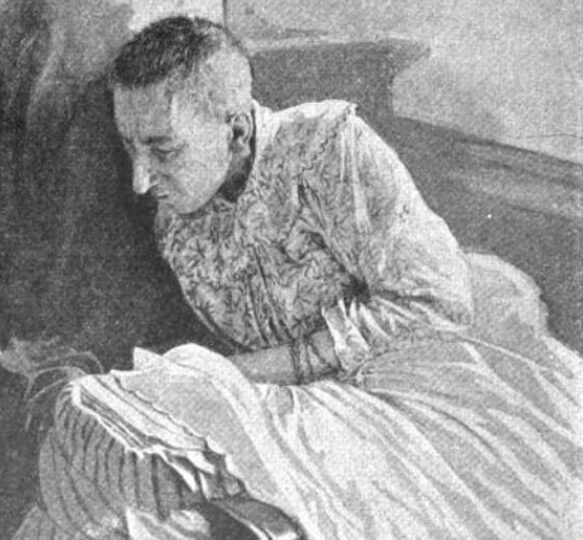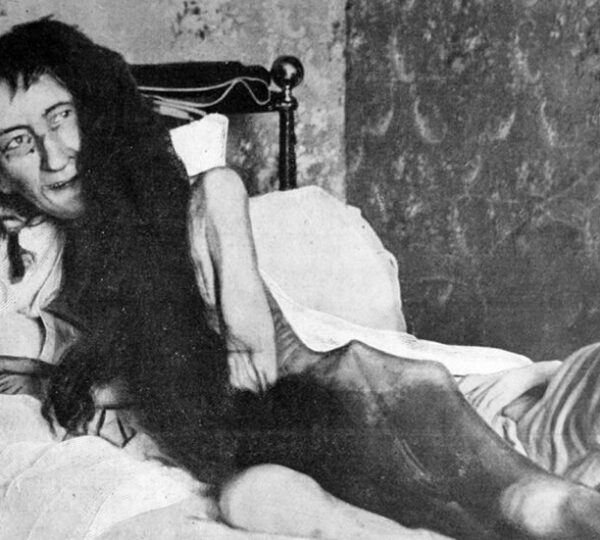A Shocking Letter That Rocked Paris
In May 1901, a single anonymous letter reached the office of the Attorney General in Paris and shattered the calm of French society. The note claimed that a woman was being held captive in a home in Poitiers, living in filth and deprived of daylight. Authorities were skeptical, but curiosity—and duty—drove them to investigate. What they discovered would horrify the world and etch the name Blanche Monnier into history as a symbol of both human cruelty and unbreakable resilience.

A Promising Young Woman from a Respected Family
Blanche Monnier was born in 1849 into a prominent and well-to-do family in Poitiers, a city in western France. Her upbringing was comfortable and cultured. Friends described her as lively, intelligent, and strikingly beautiful. In her twenties, Blanche was admired in social circles and expected to marry into a family that matched her own in status. But Blanche’s independent heart did not align with her mother’s rigid ambitions. When she fell in love with a local lawyer—an older man without wealth or aristocratic ties—her mother Louise strongly objected.
A Romance That Sparked a Nightmare
In 1876, when Blanche was 26, she simply disappeared. Friends were told she had gone traveling or chosen a life away from Poitiers. In truth, Blanche had refused to give up the man she loved, and her mother decided on a punishment beyond imagination. Louise Monnier locked her daughter in a small attic room and delivered an ultimatum: end the relationship and she would be freed. Blanche refused. Day after day, her will remained stronger than her mother’s cruelty, and what began as a temporary coercion stretched into decades of isolation.
Video : Locked Away for 25 Years: The Story of Blanche Monnier
Twenty-Five Years in a Stifling Prison
Blanche’s captivity lasted not weeks or months but twenty-five long years. The room where she was confined was barely larger than a closet, with its shutters nailed shut. Over time it became a chamber of filth and darkness. Blanche survived on scraps of food and stale bread. Without sunlight or fresh air, she grew frail and sickly. When authorities finally forced the door open in 1901, the sight stunned even seasoned police officers: Blanche weighed barely fifty-five pounds, her hair matted, her body covered in grime, and the room filled with rotting food and insects.
Rescue and Public Outrage
The rescuers carried Blanche to a Paris hospital, unsure whether she would survive. Yet she displayed astonishing resilience, recovering slowly under medical care. News of her ordeal raced through France and across Europe. Newspapers called it “The Affair of the Sequestered Woman,” and the public was both horrified and fascinated. How could a mother commit such an act—and how could an entire household and neighborhood remain silent for so long? The anonymous letter writer who revealed the crime was never identified, but their courage undeniably saved Blanche’s life.

Consequences for the Monnier Family
Louise Monnier was immediately arrested and became the subject of national fury. Yet she never expressed remorse. Fifteen days after her arrest, she died in prison, leaving behind unanswered questions about her motives and the depth of her cruelty. Blanche’s brother, Marcel, faced charges for complicity but was acquitted after claiming that his sister could have left if she wished—an explanation that most observers found implausible and morally hollow.
A Story that Echoed Around the World
The case captivated writers and intellectuals for decades. In 1930, Nobel Prize–winning author André Gide wrote La Séquestrée de Poitiers, exploring the psychological and societal forces behind Blanche’s long ordeal. Her story has since inspired numerous documentaries, articles, and works of historical analysis. Each retelling underscores the tension between social reputation and private cruelty, a theme that remains unsettlingly relevant.
Video : Why She Was Locked Up for 25 Years | Blanche Monnier
The Woman Behind the Legend
Although Blanche’s years of freedom after her rescue were relatively quiet, she became a symbol of endurance. Doctors noted her strength of mind even after years in near-total darkness. Her life reminds us how the human spirit can persist even when stripped of liberty and dignity. Blanche did not choose fame, but her story forces us to confront uncomfortable truths about family, control, and the danger of unchecked authority.
A Legacy of Resilience and Warning
Blanche Monnier’s life is more than a chilling historical footnote. It is a cautionary tale about the power dynamics within families and the ease with which cruelty can hide behind respectability. Over a century later, her story continues to resonate as a call for vigilance, compassion, and justice. The anonymous letter that revealed her suffering did more than free one woman; it ensured the world would never forget the silent endurance of a spirit that refused to break.

Conclusion: Darkness Could Not Extinguish Her Light
Blanche Monnier’s twenty-five years in a locked attic remain one of the most haunting true stories of the 20th century. She emerged fragile but alive, proof that even the deepest darkness cannot fully extinguish the will to survive. Her ordeal stands as a stark reminder: cruelty can thrive in silence, but courage—even from an unknown whistleblower—can bring hidden injustice into the light.